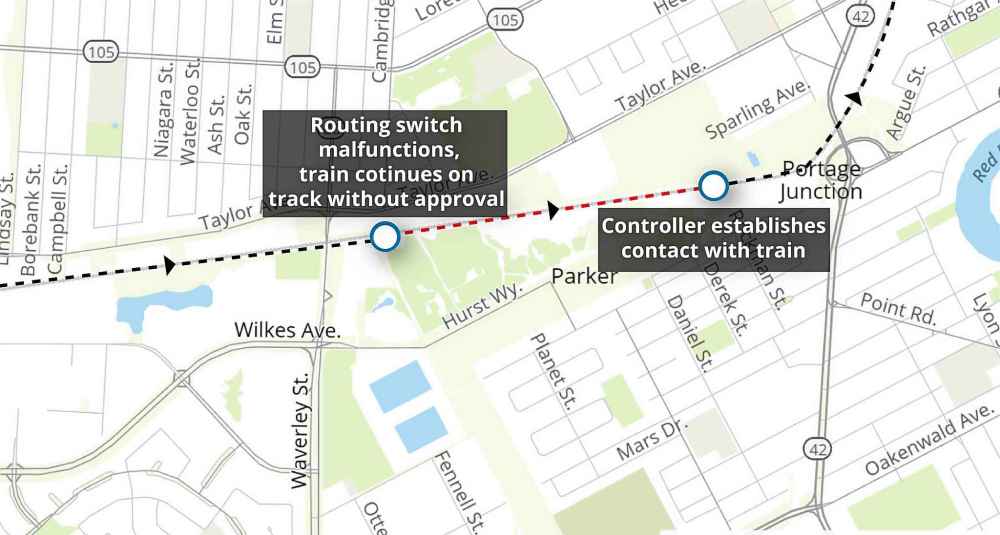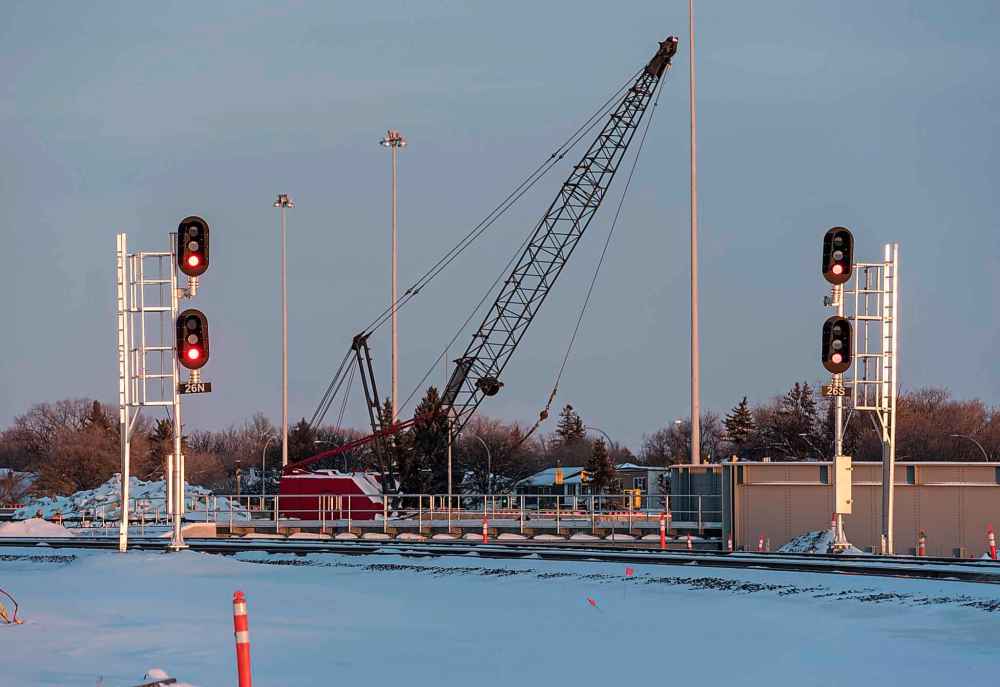Safety off the rails?
Reports to watchdog include CN workers turning off 'nuisance' malfunctioning Winnipeg warning system, inexperienced operators travelling unmonitored River Heights track
Advertisement
Read this article for free:
or
Already have an account? Log in here »
To continue reading, please subscribe:
Monthly Digital Subscription
$0 for the first 4 weeks*
- Enjoy unlimited reading on winnipegfreepress.com
- Read the E-Edition, our digital replica newspaper
- Access News Break, our award-winning app
- Play interactive puzzles
*No charge for 4 weeks then price increases to the regular rate of $19.00 plus GST every four weeks. Offer available to new and qualified returning subscribers only. Cancel any time.
Monthly Digital Subscription
$4.75/week*
- Enjoy unlimited reading on winnipegfreepress.com
- Read the E-Edition, our digital replica newspaper
- Access News Break, our award-winning app
- Play interactive puzzles
*Billed as $19 plus GST every four weeks. Cancel any time.
To continue reading, please subscribe:
Add Free Press access to your Brandon Sun subscription for only an additional
$1 for the first 4 weeks*
*Your next subscription payment will increase by $1.00 and you will be charged $16.99 plus GST for four weeks. After four weeks, your payment will increase to $23.99 plus GST every four weeks.
Read unlimited articles for free today:
or
Already have an account? Log in here »
Hey there, time traveller!
This article was published 07/01/2019 (2531 days ago), so information in it may no longer be current.
OTTAWA — When CN Rail’s warning system for runaway trains in Winnipeg wasn’t functioning correctly, workers simply turned it off. For several months.
When a locomotive crew couldn’t get a mechanical switch to route their train down a different track, they simply continued down the line behind the Grant Park Walmart without informing their supervisor.
Meanwhile, CN has changed oversight of its trains in the city to a position that requires less training.
These are among a handful of rail-safety issues the Free Press uncovered after obtaining complaints filed with the Transportation Safety Board by Winnipeg rail workers, complaints the watchdog deemed serious enough to flag for CN Rail.
The amount of oil crossing the Prairies by rail is growing exponentially, with tanker cars rolling through Winnipeg on its historic rail lines every day. Yet the TSB has warned for years that the rail industry is relying on drowsy workers, resulting in incidents that are seldom made public.
One of them occurred in Winnipeg in the early hours of Dec. 13, 2016, as a 400-metre long train was heading eastbound along one of Canada’s busiest rail lines.
“We have validated the presence of a local safety deficiency,” said Dan Holbrook, TSB’s western manager for rail investigations. He called the incident “a potentially very serious event in our railway world. This one did not lead to a collision, or anything like that — but they are important to us, as leading indicators.”
When the 25-car eastbound train running parallel to Taylor Avenue reached Waverley Street, the controller in the Symington Yard office in Transcona couldn’t determine whether an automated switch had properly aligned the track.
The controller asked the crew to stop, get out and manually turn the switch — a common procedure for train crews — so that the train would cross from the south tracks onto the north set.
The two employees weren’t able to move the switch. In that case, Holbrook said, that’s when the controller would start checking the rest of the line to see whether the train could safely proceed along the tracks it was on. The controller then would send instructions to the train crew via text message.
“They didn’t understand that their obligation was to wait until they received that written authority. And they just took it upon themselves to make that switch line up to the south track and continue on eastward on their merry way, without actually having a revised, written authority to do so,” said Holbrook, who compared the incident to flying blind.

The supervisor found out only when he asked the crew to indicate when they’d reached the next stop signal; the reply was that they were well past that point.
Holbrook said two managers operating the train were used to office jobs. “They were a management crew; they don’t normally perform these duties,” he said.
The train continued onwards to the Symington Yard without incident. “Luckily, it didn’t lead to an accident,” he said.
The incident took place 14 months after CN Rail downgraded its safety infrastructure in Winnipeg.
In October 2015, the company shifted safety duties within the city from a rail traffic controller to a yard traffic controller, a ranking that Holbrook said requires less training and adds confusion as workers are shuffled between doing network control at a dashboard and conducting locomotives on moving trains.
CN said the change instead allows local staff to focus on safety for the huge amount of rail infrastructure in Winnipeg.
In any case, the change did cause a serious public-safety risk. CN updated its software to accommodate for the switch from an RTC to a YTC, which created “an inadvertent programming anomaly,” the TSB wrote in January 2016.
Normally, an alarm in the Symington Yard office is supposed to sound when trains bypass stop signals, known as a Rule 439 alarm. Instead, the alarm started ringing each time a train passed through CN’s Winnipeg corridor, even under a green signal.
“Shortly thereafter, to address the nuisance activity of the Rule 439 alarms, they were disabled in the YTC office,” the TSB told CN Rail in a rail-safety advisory letter, obtained by the Free Press.
Advisory letters are issued only when the TSB perceives a real safety issue, not a potential one. At that point, the alarm had been switched off for three months.
“An unprotected high-risk situation can occur, which can lead to train collisions and/or derailments,” the TSB warned. “An important safety defence for train operations at this location is not immediately available.”
TSB senior member Faye Ackermans said all these problems — shortfalls in rail-worker training, technological issues, crews not communicating with supervisors — are resulting in trains travelling, in some cases, without authorization.

In fact, those types of breaches are among the most common rail-safety issues reported to the TSB. In 2017, there were 122 documented instances of what the agency calls “movement exceeds limits of authority,” and there’s been only one year in the past decade in which fewer than 100 instances were reported.
Ackermans said that within that category, about 33 incidents per year involve track signals not being followed, meaning trains are breaking speed limits or travelling on the wrong track.
She said that’s particularly concerning for Winnipeg, because of the amount of historic railway infrastructure adjacent to densely populated buildings.
“If it’s in the middle of a town, or a large urban centre, there can be a real risk,” she said. “It can have catastrophic effects.”
It’s unclear whether last Thursday’s derailment near Portage la Prairie was a result of a staff not following signals. Two trains headed in the same direction and collided, leaking diesel into a ditch near the Assiniboine River. That derailment remains under investigation.
The December 2016 incident in Winnipeg involving the switch happened in the riding of Jim Carr, who represents Manitoba in the federal cabinet.
“I know that (Transport Canada) looks into all near-misses, including one that occurred in Winnipeg,” Carr told the Free Press. He noted that Transport Minister Marc Garneau is working on new rail-safety regulations.
“You’re always concerned when an accident is possible, and you want to make sure than an accident won’t happen, and that every precaution has been taken. And I know that Minister Garneau believes this to be his No. 1 priority. And I have full confidence that he will do whatever’s necessary to keep us safe.”
The Railway Association of Canada would not comment on the incident. CN spokesman Jonathan Abecassis said the company’s records suggest the train in the December 2016 incident proceeded in the absence of an oncoming train.
“Safety is a core value at CN,” Abecassis wrote, citing federal law and measures meant to protect both staff and neighbouring communities. “We have followed up on the incident and the matter has been closed.”
dylan.robertson@freepress.mb.ca
This is the second instalment in a three-part series examining safety issues along Winnipeg’s railway tracks, amid a historic increase in the volume of oil being shipped by rail.
Transportation Safety Board documentation on Winnipeg rail-safety issues
History
Updated on Monday, January 7, 2019 9:07 AM CST: Changes subheadline






